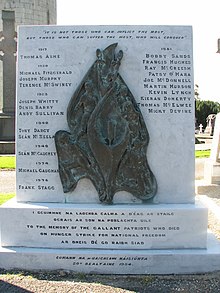Tony D'Arcy
Tony D'Arcy was a senior leader in the Irish Republican Army (IRA) who died as a result of a 52 day Hunger-strike (16 April 1940) at the age of 32.
Background, roles in the IRA and arrest[edit]
D'Arcy was from north Galway and a member of the IRA during the 1930s. Tonys cousin Louis Darcy, was Commandant of North Galway Brigade IRA during the Irish War of Independence and was killed by British forces in March 1921 at the age of 23.
In 1938 Sean Russell appointed Volunteer Tony D’Arcy to the IRAs Army Council and the Officer Commanding (O/C) of the IRAs Western Command.[1] By 1938 D'Arcy had become a key target for the Irish police Special Branch.[2] In 1939 he was assigned to the IRA's Headquarters staff. D'Arcy and the younger members of the Headquarters – Michael Traynor and Jack McNeela proposed the launching of raids from the Free State across the border into Northern Ireland. This proposal eventually became the 1959–62 Border campaign.[3]
On 17 Feb 1940 D'Arcy (and 15 other high ranking IRA men) were arrested at a meeting in a Dublin hotel. The topic of the meeting was planning for the upcoming Northern Campaign (September 1942 – December 1944), these arrests were a severe blow to the IRA organization. The men arrested were imprisoned in Mountjoy Prison during what was called The Emergency in Ireland.[4] D'Arcy was sentenced to three months for refusing to account for his movements and for not giving his name and address when arrested.[5] On Sunday 25 February 1940, six republican prisoners embarked on a hunger strike demanding free association and to have two prisoners (IRA Volunteers Nicky Doherty of County Meath and John Dwyer) moved from the criminal wing to the republican area within the prison (Mountjoy Jail).[6]
Hunger strike, death and response[edit]
Joining D’Arcy in the hunger strike were his cell mate Jack McNeela, Tomás Mac Curtain Jr. (the son of the assassinated Lord Mayor of Cork) Tomás Mac Curtain , Jack Plunkett of Dublin, son of Count Plunkett and brother of Joseph Mary Plunkett (executed for his roles in the Easter Rising of 1916), Tommy Grogan of Drogheda and Michael Traynor of Belfast (later named Ard-Rúnaí (Secretary General) of Sinn Féin).[7] Close to the annual commemoration of the Easter Rising of 1916, a letter of protest criticizing the governments policy towards the hunger strikers was published from relatives of participants in the Easter Rising and the Lord Mayor of Dublin Kathleen Clarke, the wife of Tom Clarke and sister of Edward Daly (both executed in the Easter Rising of 1916).
After seven days of hunger strike the six strikers were told they would have to stand trial. They were to be represented by the well known Irish Republican and future Nobel Peace Prize winner Seán MacBride.[8] The hunger strikers refused to go to trial and fought off attempts to bring them to court. D'Arcy, McNeela and Tom Grogan were very badly beaten.[9] D'Arcy was sentenced to three months on 5 March 1940. D'Arcy, Grogan and McNeela decided to continue their hunger strike.[10] While Grogan survived, Tony D'Arcy and Jack McNeela died within three days of each other on hunger strike in the Military Wing of St Bricins Hospital, Dublin.[11]
The IRA responded to the death of two of its officers with an attack on the seat of the Irish Government – Dublin Castle. In the early morning hours of 25 April 1940, a large land mine was detonated in the Lower Castle Yard which was housed the Detective Division (or Special Branch). Five Detectives reported injury and windows were blown out in the Chapel Royal and State Apartments.[12]
At the time of his death D'Arcy was married with three young children. An owner of a garage and a undertaker by profession, his body was carried in his own hearse, driven by neighbor Joe Glynn of Headford. He was buried at Donaghpatrick Cemetery, Headford (his hometown), County Galway.[13]
Between 1917 and 1981 a total of 22 Irish Republicans have died on Hunger-Strike.[14] The largest hunger strike in Irish history was the 1923 Irish Hunger Strikes.

See also[edit]
- Louis Darcy (his cousin)
References[edit]
- ^ Flynn, Barry, Pawns in the Game, Collins Press, Cork, Ireland 2011, pg 97, ISBN 9781848891166
- ^ Flynn, pg 97
- ^ McKenna, J. (2016), The IRA Bombing Campaign Against Britain, 1939–1940. McFarland Incorporated Publishers. Jefferson NC, p. 162. ISBN 9781476623726
- ^ Thorne, Kathleen (2019). Echoes of Their Footsteps. Oregon: Generation Organization. p. 235. ISBN 978-0-692-04283-0.
- ^ "The Forgotten Hunger Strikes". hungerstrikes.org. Retrieved 5 October 2020.
- ^ Flynn, pg 94.
- ^ Mac Thomais, Shane (20 April 2016). "Seán McNeela and Tony D'Arcy die on hunger strike in Dublin". An Phoblacht. Retrieved 21 May 2022.
- ^ Thorne, Pg.156
- ^ MacEoin, Uinseann (1997), The IRA in the twilight years 1923–1948, Argenta Publications, Dublin, pg 614, ISBN 0951117246
- ^ Thorne, Pg. 239
- ^ O'Malley, Padraig, Biting at the Grave, (1999), Beacon Press, Boston pg 27, ISBN 0-8070-0208-9
- ^ MacEoin, pg 888
- ^ Callinan, Luke (21 April 2020). "Volunteer Tony D'Arcy's death on Hunger Strike". An Phoblacht. Retrieved 26 March 2022.
- ^ "Roll of Honor/Hunger Strikers". 6 May 2014.
Sources[edit]
- http://hungerstrikes.org/forgotten_strikes.html
- Northern Nationalism, Eamon Phoenix, Ulster Historical Foundation, Belfast 1994 ISBN 0-901905-64-X
- The History and Folklore of the Barony of Clare, Michael J. Hughes, c. 1993.
- Biting at the Grave, O'Malley, Padraig, Beacon Press, Boston 1990 ISBN 0-8070-0208-9
- Pawns in the Game, Flynn, Barry, 2011, Collins Press, Cork, Ireland ISBN 9781848891166
